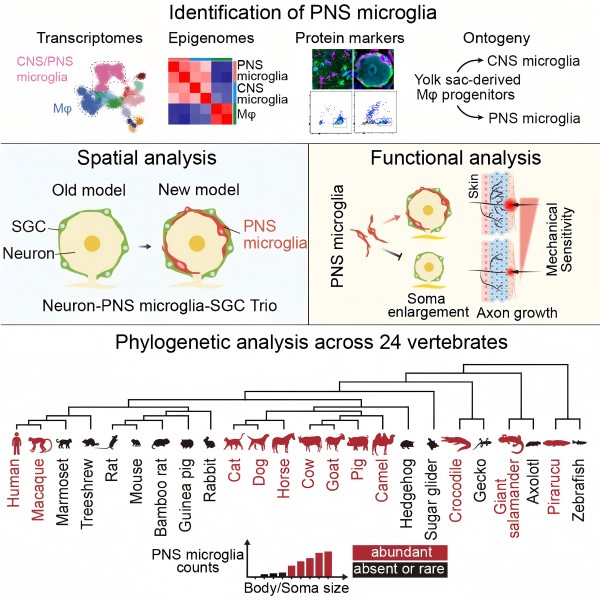

The development, function, and evolution of microglia in the peripheral
nervous system
Under the support of the National Natural Science Foundation of China
(Grant No.: 32425024, etc.), the research team of Li Hanjie from the Chinese
Academy of Sciences Shenzhen Institute of Advanced Technology cooperated with
the team of Professor Chen Yun from Nanjing Medical University to make new
progress in the research on the evolution of microglia. The research results
were entitled "Peripheral nerve system microglia like cells can regulate
neuronal soma size through evolution" and published online in Cell on April 7,
2025. Paper link: https://doi.org/10.1016/j.cell.2025.02.007 .
As an important component of the immune system, macrophages are widely
distributed in different tissues and organs, playing a crucial role in embryonic
development, organ formation, homeostasis maintenance, and disease occurrence
and development. Macrophage subpopulations are diverse and functionally complex.
Among them, microglia, as a special member of the macrophage family, are widely
involved in physiological and pathological processes such as central nervous
system immune monitoring, inflammatory response, neurodevelopment, and
degenerative diseases. Due to the large-scale application of rodent models, it
was previously believed that microglia did not exist in the peripheral nervous
system.
Li Hanjie's research team used multidimensional research such as
single-cell transcriptomics, epigenetics, characteristic protein expression, and
developmental origin to identify for the first time a group of microglia cells
related to species size and encapsulating neuronal bodies in the peripheral
nervous system. Further functional studies have revealed the important role of
peripheral nervous system microglia in neuronal cell body enlargement, axonal
growth, and functional maturation. At the same time, multi species phylogenetic
analysis also shows that peripheral nervous system microglia have ancient
origins and are positively correlated with species body size and peripheral
neuron cell size, which confirms the results of peripheral nervous system
microglia regulating neuronal function mentioned above (Figure).
This study not only proposes new immune neural interaction patterns, but
also expands our understanding of the distribution and function of microglia.
The discovery of microglia in the peripheral nervous system breaks through the
century old notion that microglia only exist in the central nervous system, and
provides a new perspective for the study of peripheral nervous system
development and related diseases.